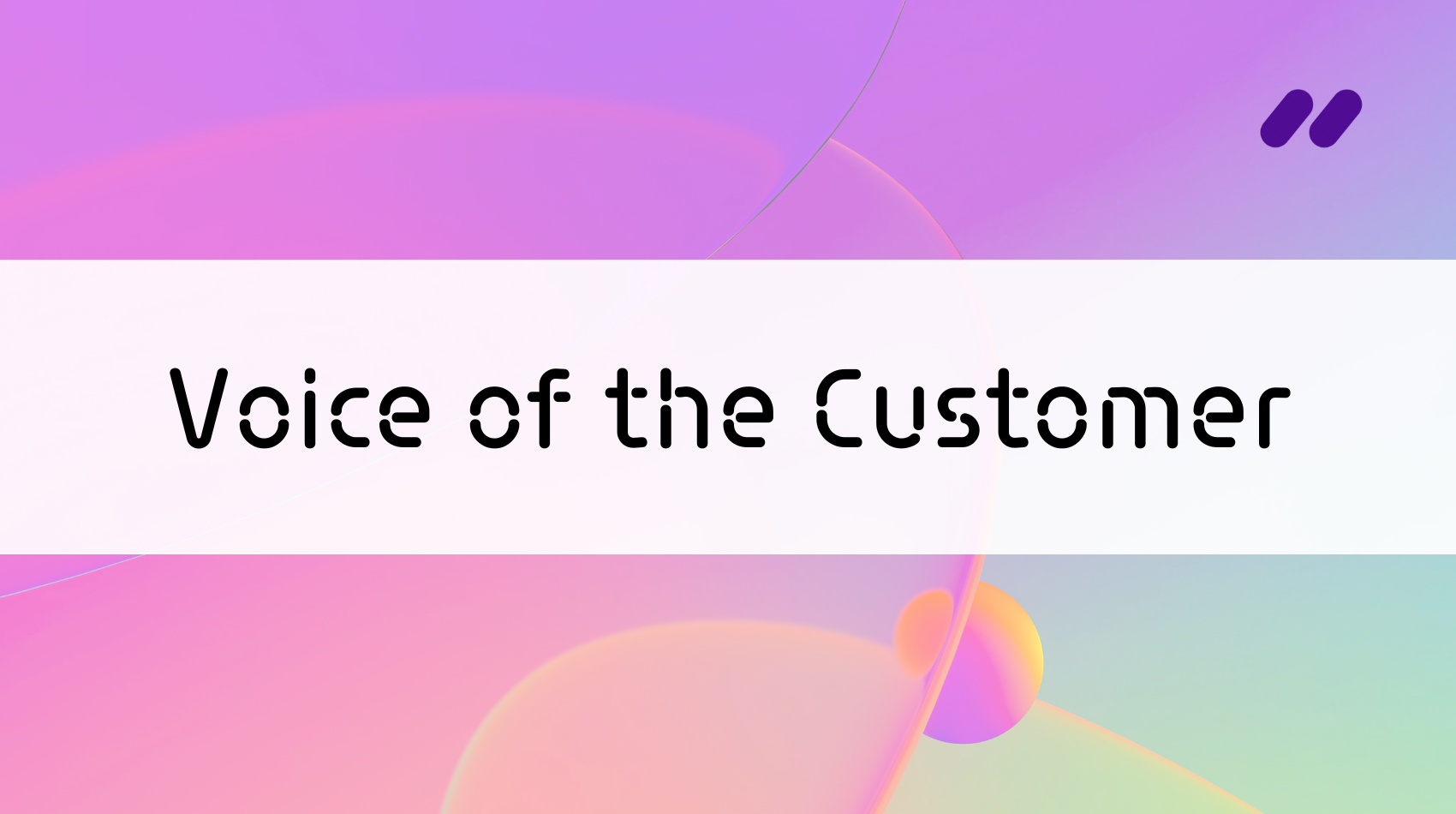So, you work in customer experience. You might be responsible for tasks like collecting and monitoring customer feedback, compiling data, analyzing data, reporting on the insights you’ve found, and following up with actions to improve customer satisfaction.
On top of that, maybe you have some procedure for how to manage and automate those tasks – or maybe you don’t. Either way, this work is complex and can be strengthened with the right technology and software solutions.
In this post, we’ve brought together the most valuable insights from other posts we’ve written, in order to give you a complete view of the activities involved in the voice of the customer. As a text analytics company, we’re deeply involved in the customer experience space and we know how the pieces of the process fit together. We’ve tried to keep this post conversational and less “SEO”. If that’s your style, read on!
First, let’s define a few things
Before we jump into this post it will be useful to set a few definitions at the start. So let’s get to it:
- Customer experience (CX): Refers to how customers feel at every interaction they have with a business, whether it’s online, on the phone, or in-store
- Customer feedback loop: Describes the activities involved in collecting feedback, analyzing data, finding insights, and taking actions to ensure customer satisfaction – altogether these activities help you “close the loop” with the customer
- Voice of customer (VOC): In business, VOC refers to what customers are saying about a company; a business can collect voice of customer data from online feedback channels
- VOC program: Refers to what a company is actually doing about the feedback they are getting from customers, using voice of customer software to close the customer feedback loop
1. Why you need a voice of customer program
We have a complete post on this topic that you can check out! The TLDR: businesses that invest in the voice of the customer see a measurable return on investment. Studies have shown that these companies:
- Have much higher client retention and employee engagement
- Spend less on customer service
- Generate a year-over-year increase in annual revenue that’s 10 times greater than other companies
Especially since the huge shift to digital experiences in 2020, customer experience has emerged as the new battleground for brands. Having a voice of customer program is mission-critical to stay competitive. The benefit of a voice of customer solution is clear: you simply have more data to make decisions. Wouldn’t you want to know exactly what this data can tell you, if it would help inform the direction of your business?
Business aside, there’s a philosophy to the voice of the customer, too. It’s not only about data – it’s about people. When people take the time to write comments and reviews, answer surveys, or chat with your customer support team, it’s because they have something to say. If you don’t take the time to use that data, it’s a breach of trust. And trust is what customers value above all else today: as much as 83% won’t buy from a brand they don’t trust.
In reality, though, there are lots of organizational challenges to fully embrace a data-driven, customer-centric mindset and put a VOC solution at the heart of your business. Not only that, but you would also want to do it well. The bigger a company is, the more work involved to centralize omnichannel customer feedback for easy access to insights and clear paths to action. That’s what the rest of the customer feedback loop is for – and where technology comes into play.
2. What to consider in collecting customer feedback
The quality of everything that follows in the customer feedback loop depends on the quality of feedback that you collect and how you organize it. A solid voice of customer methodology that standardizes your VOC practices will help guide your feedback collection process. The main challenge is when you have several distinct channels where feedback might be coming in: reviews, surveys, support tickets, chat conversations, social media, even contact center phone calls.
Building trust with customers means opening channels for communication. Instead of shying away from the voice of the customer – especially when it’s negative feedback – giving customers a platform to voice their opinions is actually a good thing for your business. That’s because the customer can speak their mind and it allows you, as a brand, to respond thoughtfully and mitigate the potential loss of a customer. Most customers who complain just want to be heard; in fact, up to 70 percent will do business with a company again if the complaint is resolved, and if the complaint is resolved quickly, that number jumps to 96 percent. Essentially, what matters is that you use negative feedback in a positive way.
Negative feedback is generally what we talk about with “closing the loop”, as the actions you can take to respond to these customers can have a huge impact on your business. For instance, you can follow up directly with customers who left survey responses associated with a low satisfaction score (detractors, if you’re using NPS terminology) in order to try to save them from completely churning. Voice of customer tools enable you to manage these follow-ups.
As you can see, the name of the game today is actionable feedback. If you’re collecting feedback and listening to the voice of the customer, it shouldn’t be empty data; it should lead to a proactive next step. Let’s consider how you can make different feedback channels actionable:
- Surveys: Crafting the right open-ended questions, paired with an NPS or CSAT score, to understand exactly which elements of the customer experience are creating friction
- Reviews and social media: Responding quickly and thoughtfully to negative comments to mitigate the customer’s bad experience and their impact on brand reputation
- Chat conversations: Using conversational data to map out and automate answers to common questions
- Support tickets: Measuring customer sentiment associated with a particular agent and using these insights to inform agent training and help them better answer customers’ concerns
3. Setting up your feedback channels for success
Each feedback channel can be managed in different ways to enhance the quality of VOC data collected. You can imagine that certain channels like surveys can be curated more than others. For instance, CX teams have control over the questions presented in a survey, whereas they do not have the same control over product reviews. So, considering how to best collect feedback from each channel is important for the success of your VOC analysis.
- Voice of customer surveys: Any kind of customer survey allows you to directly hear open-ended feedback from customers. Of course, this is where survey design comes into play. Especially if you have the right VOC tools in place to analyze the responses, you can transition from closed-ended questions to open-ended questions. Imagine the different levels of insight you can get from asking “Were you satisfied with your experience with us” versus “How do you feel about your experience with us?”.
- Comments on social media and in reviews: In this scenario, feedback is simply aggregated. Interestingly, though, this channel is highly important because of the fact that you have no way to guide customers’ comments. We will see later in the post that “learning what you don’t know” is a huge part of successful voice of customer analysis. Customers on social channels are telling you exactly what they care about, regardless of whether you asked or not. It’s your job to listen!
- Chat and contact center interactions: Any time a customer speaks with an agent through a chat, ticket, or even phone call, you may consider that there are two parties involved in the customer’s experience: your general brand and the person representing it. Customer satisfaction can be measured in relation to their experience with a particular agent at your company. As these people are working often with at-risk customers who are experiencing friction with your products or services, their ability to answer questions, respond empathically to concerns, and make the customer feel supported contributes greatly to your customer experience. Don’t let it go unanalyzed!
The voice of the customer goes beyond the process of understanding what the customer says. Ultimately, you have to understand the root causes of customer issues to truly fulfill the feedback loop. It’s not only about responding to customers, necessarily, but fixing product issues, improving customer service experiences, and making the customer feel like you have taken steps to address their concerns. In order to get to this level of actionable insights, look no further than a text analytics solution.
Case study: Lenovo analyzes global licensee feedback for 250+ products
As we saw in the previous section, collecting feedback is the important first step to accurate text analysis and actionable VOC insights. Keatext helps Lenovo aggregate feedback from all their global licensing channels and manage a unified feedback analysis system.
Quick view:
- The situation: Licensees in 180+ markets with 250+ products
- The problem: Lenovo faced difficulty accurately collecting customer feedback to measure licensee performance
- The solution: Keatext’s scalable voice of the customer analytics have tackled 120,000 comments and counting for Lenovo
- The impact: Digital transformation of Lenovo’s feedback analysis system to improve licensee performance and onboarding
Implementing Keatext has resulted in a simpler, more automated way for the team at Lenovo to manage quality across a diverse portfolio of licensees and marketplaces. Keatext adds another layer of depth and analysis, improving visibility into licensee performance while providing Lenovo with the actionable insights they need to make ongoing improvements.
Read the full case study here.
4. Making your VOC program actionable with text analytics technology
Collecting feedback, of course, is only one piece of the puzzle. Analyzing the feedback you’ve collected is a challenge on its own, and there comes a point where you will need a technology solution to manage the volume of feedback you’re getting and dig into more granular insights. Text analytics technology is the bread and butter of the analysis involved in a VOC software. It automates the important work of simply reading through all the comments left by customers.
As a technology applied to the voice of the customer, text analytics can:
- Identify topics mentioned by customers and the associated sentiments
- Detect trends in the data and track them over time
- Pinpoint the topics that have the greatest impact on a customer satisfaction rating like NPS or CSAT
- Generate recommendations on how to improve business areas that are reflecting a poor customer experience
- Produce quantitative voice of customer metrics from qualitative text data
This level of automation leverages AI, and when compared in this lens, not all text analytics solutions are the same. Keatext’s CEO Narjès Boufaden tells us that “with old-school text analytics, companies had to come up with 20 or 30 keywords to search. That isn’t good enough anymore. AI now identifies the important words on its own, learning in context without the need for anyone to customize a vocabulary of relevant words or phrases for each industry. Then it points to issues you don’t even know exist. It uncovers new insights and new client needs.”
That right there is an essential component of an effective VOC strategy. Text analytics removes bias from the analysis of feedback and ensures the accuracy of insights. Without it, you could think you know where the problem lies, end up spending money on the wrong things (even with the best intentions), and ultimately jeopardize your VOC program’s success and executive buy-in. The ability to uncover insights that surprise you – the idea of “learning what you don’t know” – is a crucial element of truly listening to the voice of the customer.
When we talk about making insights actionable, getting them to the right business units is the necessary second step after finding the insights themselves. Text analytics technology is the engine that enables you to pinpoint voices of the customer (see what we did there?) that have a big impact on overall satisfaction. Then, you have to report and share these insights. How do you do that?
5. How to report and share insights to close the feedback loop
The basic idea of this stage of closing the feedback loop can be summed up as “insights are no good unless you can get them to the right people”. It’s easy to overlook this stage: out of the 95% of companies that collect customer feedback, 10% actually apply it to product developments, and only 5% follow up directly with customers about the feedback they left. That’s a pretty elite top 5% to be a part of!
Generally speaking, VOC best practices rely on feedback management software like Keatext to assist with the reporting process. This kind of software has a core text analytics engine to analyze data, and built on top of it are functionalities that make the solution practical and capable of addressing the changing needs of business users. Features like data visualization, dashboarding, report creation, and predictive analytics help the people on the ground prepare and share insights with the right stakeholders, who are then responsible for taking the appropriate actions.
A strong VOC program ultimately supports the business, but in order to do this it has to first support the end users (that’s you!). Managers and analysts within CX teams are responsible for preparing reports, developing recommendations for action, and sharing these assets with the correct business units. Any automation that can be applied to these tasks reduces the time it takes to close the feedback loop, whether it’s replying directly to a customer or planning important product changes to solve customer pain points. And as we saw earlier, time is of the essence when it comes to responding to negative comments and detractors.
Case study: Intelcom builds a data-driven VOC program with Keatext
Keatext gave Intelcom’s team the scalable analytics they needed to evolve from doing manual VOC reports to championing a robust CX strategy that brings together multiple teams at the organization around a common methodology: using customer insights to drive decision-making.
Quick view:
- The situation: 5000 daily responses from post-delivery and post-return CSAT surveys
- The problem: No data-driven, scalable VOC solution to gain insights from open-ended responses
- The solution: Keatext’s strong text analytics and SWOT recommendations formed the foundation for Intelcom’s VOC methodology
- The impact: Digital transformation of Intelcom’s CX practices, led by the team at Intelcom championing Keatext
Keatext introduced a level of automation and data analytics that enabled Intelcom’s team to identify the most common concerns, questions, and suggestions from customers. Using Keatext for this purpose enables Intelcom to automatically categorize cases and route them to the most appropriate business unit. This has a high ROI for the team, directly impacting responsiveness and helping them to better structure their service offerings.
Read the full case study here.
6. Getting executive buy-in for your voice of the customer program
For those of you who are reading this article in the hopes of launching your own voice of the customer strategy, this section is for you. We’ve all been there: you totally know that a certain strategy is the right move for your business, and no matter how well you champion it to upper management, they just don’t see the value. Thankfully, that won’t be you – because you’re going to have a plan.
Executives considering a new initiative will mostly be concerned with the return on investment (ROI). As a business, if you’re going to spend money on something, you hope to see that investment reflected in greater performance. In the realm of customer experience, this could look like:
- Greater customer retention and less churn
- Increase in customer satisfaction scores like NPS
- Improvement in brand reputation online
- Customer loyalty reflected in repeated purchases, upsells, or resells
- Understanding of how CX metrics translate to larger business objectives, especially revenue
Advocating for the tangible results you hope to see from your VOC program will go a long way in demonstrating ROI at the executive levels. Other considerations beyond this are related to any specific software solutions you hope to include in your program. Especially for text analytics software, you should carefully consider how you will handle elements like adoption, organizational change, scalability, and integration with your existing tech stack. Never fear, though: we have a full article on these considerations!
Securing the executive buy-in involves some level of predicting performance based on research, case studies in your industry, and benchmarks. Once your VOC program is approved and launched, you can begin to measure performance and track the impact on revenue much more accurately. This will enable you to continue to get that executive buy-in and support your future initiatives! Planning ahead and preparing what you need to pitch your idea will not let you down.
Choose Keatext for your voice of customer program
If you found this post useful, you might find our platform even more so! Here are a few points about how Keatext is made to support you and your VOC program:
- AI-driven text analytics: A feedback management software is only as good as the quality of insights it can uncover. Our core text analytics engine is strong enough to learn and adapt to the unique context of your data.
- Automated voice of customer reports: Keatext aggregates the top opportunities identified from your VOC data to improve customer satisfaction, all in one easy PDF. You can instantly export a summary of these insights to close the customer feedback loop.
- Recommendations: Thanks to an intelligent integration with OpenAI’s GPT, we built a way to use Keatext as a knowledge base to generate natural language recommendations based on the voice of the customer.
- Dashboard visualizations: Build and customize VOC dashboards with flexible widgets like a pie chart, sentiment score, heatmap, time series, and more.
A lot of the work we’re doing is to automate the activities involved in closing the loop with customers beyond the analysis of data, like visualizing insights, preparing recommendations, and sharing voice of customer reports. At Keatext, supporting people like you in your everyday work is always on our minds as we continue to build our platform. If you believe in your VOC program, we believe in you too!





